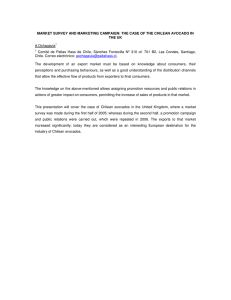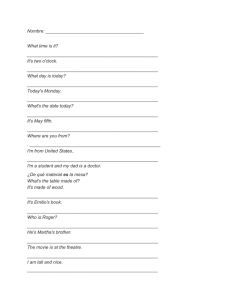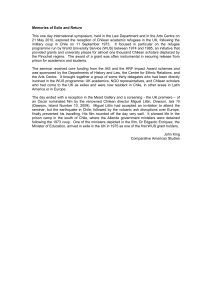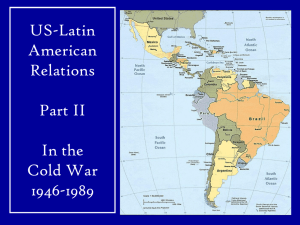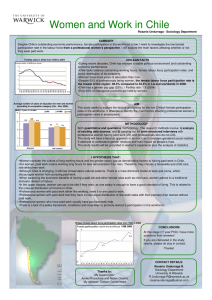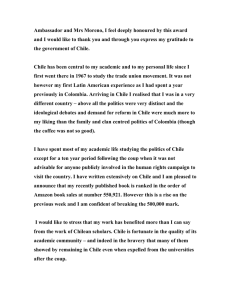Exploring Chile’s Torres del Paine National Park SPANISH LESSON OF THE MONTH
advertisement
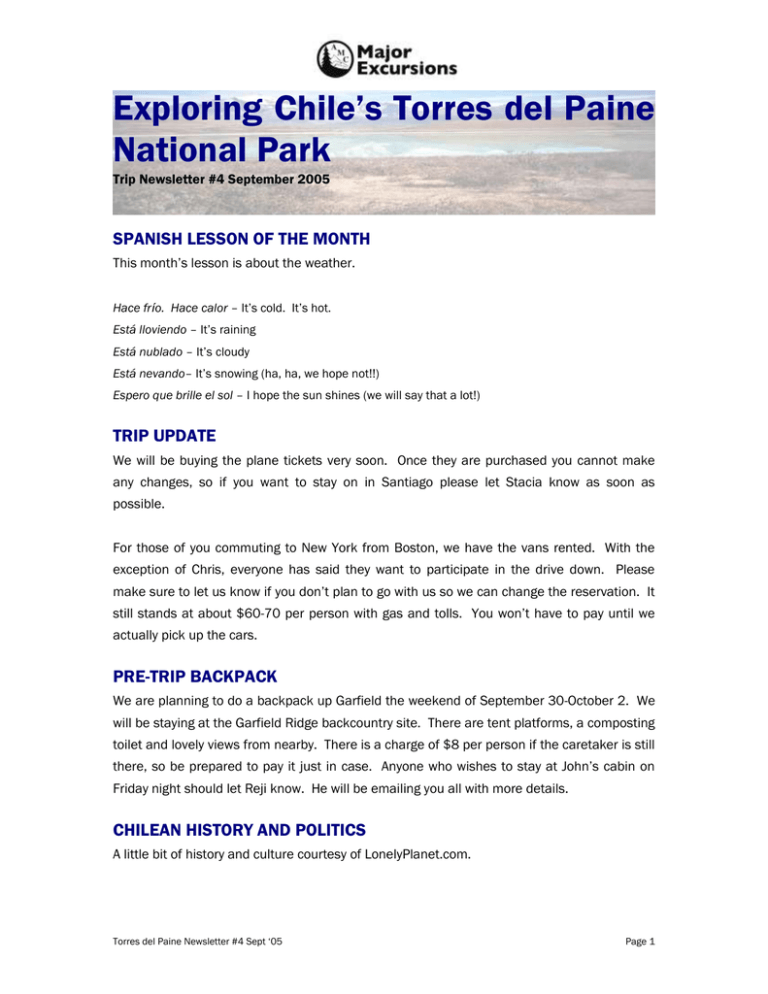
Exploring Chile’s Torres del Paine National Park Trip Newsletter #4 September 2005 SPANISH LESSON OF THE MONTH This month’s lesson is about the weather. Hace frío. Hace calor – It’s cold. It’s hot. Está lloviendo – It’s raining Está nublado – It’s cloudy Está nevando– It’s snowing (ha, ha, we hope not!!) Espero que brille el sol – I hope the sun shines (we will say that a lot!) TRIP UPDATE We will be buying the plane tickets very soon. Once they are purchased you cannot make any changes, so if you want to stay on in Santiago please let Stacia know as soon as possible. For those of you commuting to New York from Boston, we have the vans rented. With the exception of Chris, everyone has said they want to participate in the drive down. Please make sure to let us know if you don’t plan to go with us so we can change the reservation. It still stands at about $60-70 per person with gas and tolls. You won’t have to pay until we actually pick up the cars. PRE-TRIP BACKPACK We are planning to do a backpack up Garfield the weekend of September 30-October 2. We will be staying at the Garfield Ridge backcountry site. There are tent platforms, a composting toilet and lovely views from nearby. There is a charge of $8 per person if the caretaker is still there, so be prepared to pay it just in case. Anyone who wishes to stay at John’s cabin on Friday night should let Reji know. He will be emailing you all with more details. CHILEAN HISTORY AND POLITICS A little bit of history and culture courtesy of LonelyPlanet.com. Torres del Paine Newsletter #4 Sept ‘05 Page 1 Pre 20th Century History Pre-Columbian Chile was peopled by a variety of ancient cultures, many of them politically subject to the Incas who they predated by many centuries. The country's varied topography governed the character of its population groups and the extent to which they were subject to Inca aggression. Native groupings included Aymara farmers in the desert north, who cultivated maize and tended flocks of llamas and alpacas; fisherfolk in the coastal areas; Diaguita Indians in the mountainous interior; Araucarian Indians in the centre and south, whose fishing and agricultural settlements were barely touched by Incan incursions; and numerous groups of archipelagic hunters and fishers in the remote south. All territory west of Brazil was granted to Spain by the 1494 Spanish-Portuguese treaty. The Spanish assigned the task of conquering Chile to Pedro de Valdivia, whose expedition reached Chile's fertile Mapocho Valley in 1541. Santiago was founded in the same year, with the cities of La Serena, Valparaíso, Concepción, Valdivia and Villarrica following soon after. The Río Biobío marked the southern extent of Spanish incursions, where they were barred by the resistance of the fierce Mapuche tribes. Valdivia rewarded his followers with enormous land grants, which resembled the great feudal estates of his Spanish homeland. Although mining and business outstripped agriculture as Chile's merchant megaliths, it was the social structure of the estates that shaped colonial Chile. The native population was devastated by the unwitting introduction of infectious diseases, and the mestizo population, the offspring of Spanish and Indian unions, were used as tenant laborers on these huge estates, many of which were still intact in the 1960s. By the 1820s, the cumbersome methods by which taxation was extracted by a stagnant and complacent Spain allowed a flowering pan-American identity to blossom into a push for full independence. Simón Bolívar and José de San Martín led armies of freedom fighters from Venezuela to Peru, and from Argentina into Chile. Bernardo O'Higgins, son of an Irish immigrant and erstwhile viceroy of Peru, became supreme director of the new Chilean republic. The newly independent Chile was a fraction of its eventual size, consisting of Santiago and Concepción, and had fuzzy borders with Bolivia and Argentina. The coming of the railways and military triumphs over Peru and Bolivia in the War of the Pacific (1879-83) incorporated the mineral-rich Atacama desert to the north and the southern temperate territories. Chile quickly achieved a degree of political stability and relative democracy, Torres del Paine Newsletter #4 Sept ‘05 Page 2 enabling rapid agricultural development and the advancement of mining, industry and commerce. The now empowered working class and the nouveau riche both challenged the political power of the landowning oligarchy in a brief but bloody civil war in the 1890s. Modern History The first half of the 20th century saw the political climate swing between right and left with no government having sufficient support to cement large-scale reform. Infrastructure development was generally sluggish, leading to rural poverty and urbanization through desperation. It was not until the 1960s that social reforms were successfully instituted by the Christian Democrats, who targeted housing, education, health and social services. These policies threatened the conservative elite's privileges and also offended the radical left. Chile's politics were becoming increasingly militant, polarised and ideology-based when the Marxist Allende's leftist coalition of Socialists, Communists and extremists snuck to victory in 1970. Allende introduced sweeping economic reforms, including the state takeover of many private enterprises and the wholesale redistribution of income. The country was plunged into economic chaos and the USA was miffed by the expropriation of US-controlled copper mines, and also by Chile's conspicuously friendly relations with Castro's Cuba. General Pinochet seized power in a bloody coup on 11 September 1973 using jets to bomb the presidential palace. Allende died, apparently by his own hand, and thousands of his supporters were murdered. Dark days followed, with assassinations, purges and enforced exiles commonplace. It is estimated that as many as 80,000 people were tortured or murdered. Rumors of CIA involvement in the coup were given credence by the US-instigated suspension of credit from international finance organisations, and the contemporaneous financial and moral support given to Allende's opponents. At the head of a four-man junta, Pinochet dissolved Congress, banned leftist parties and suspended all opposition. Pinochet's monetarist economic policies brought stability and relative prosperity, but in a 1988 referendum to approve his presidency, voters rejected him by a majority of 12%. In the 1989 multiparty elections, Christian Democrat Patricio Aylwin beat Pinochet's candidate, Hernan Buchi, and power was peacefully transferred. Democracy returned to Chile although many of the previous regime's power brokers wield a lingering influence. Torres del Paine Newsletter #4 Sept ‘05 Page 3 Eduardo Frei undertook the challenge of reconciling Chileans with their difficult past by accelerating human rights tribunals and inquiries into the fate of Chile's 3000 disappeared. Unfortunately, resistance from the political arm of the military machine severly hampered his efforts. Frei also struggled in matters of constitutional reform, failing to eliminate eight institutional senators appointed by Pinochet who are not subject to a popular vote. Frei's economic reforms, however, did help alleviate crushing poverty to some degree. Newly elected President Ricardo Lagos, formerly Frei's public works minister, is the first Socialist to hold the highest office since Allende. He defeated his right-wing rival, Joaquin Lavin, by a thin margin, securing 51.3% of the vote. Recent History Chile's copper-dependent economy is a regional leader, growing steadily through the 1990s and riding recent bumps with confidence. Pinochet has continued to dominate recent political history. His arrest in London in 1999 at the request of a Spanish judge investigating human rights violations unleashed an international furore. In February 2000 the general was pronounced too ill to stand trial and in early March he returned to Chile, where a court stripped him of his immunity from prosecution and he was formally charged with kidnapping. In July 2001, a Chilean Court ruled that Pinochet was unfit to stand trial. This setback for those seeking judicial restitution also meant that Pinochet could no longer hold on to his lifelong senatorial sinecure. Three years later, after a series of trials, the Supreme Court upheld a lower court's decision to strip Pinochet of his immunity from prosecution. CHILEAN CULTURE 101 A little bit of history and culture courtesy of the Chilean Information Project. Art and Literature Chile's most famous contributions to literature have come from Nobel Prize poets Pablo Neruda and Gabriela Mistral, whose homes and birthplaces are now museums that attract literary pilgrims to Chile. Neruda's Heights of Machu Picchu, Canto General and the autobiographical Memoirs are widely available in English, however Mistral's works are harder to find. Contemporary Chilean authors have earned an international reputation in the literary world. The most famous is novelist Isabel Allende, whose House of the Spirits, Of Love and Shadows, and Eva Luna have all been international bestsellers. The increasingly popular Luis Sepúlveda has written stylish short novels like The Old Man Who Read Love Stories, and Torres del Paine Newsletter #4 Sept ‘05 Page 4 combines travel writing with imaginative fiction in Full Circle: a South American Journey. José Donoso's novel Curfew recalls the latter days of the recent military dictatorship, while Antonio Skármeta's novel Burning Patience (drawing on Neruda's life as a Chilean icon) was the inspiration for the Oscar-winning Italian film, Il Postino (The Postman). Ariel Dorfman is an internationally known critic, novelist, and playwright who is also active in human rights causes. His play, Death and the Maiden, was made into an English-language film. The most successful play in the 1990s has been La Negra Ester - a dramatic adaptation of a poem dealing with characters working at a seaport brothel, written by Roberto Parra. La Negra Ester is revived yearly for audiences and is sold out weeks in advance. Santiago's Municipal Theater, since its creation in 1857, has played a critical role in disseminating the arts: visits by national and international celebrities entertain audiences with concerts, operas and ballets. Music Chilean music, particularly folk music, has had international acclaim since the 1960s, when Violeta Parra and her children Angel and Isabel made their names as politically committed singers and songwriters. During the 1970's and later as exiles, folk groups like Quilapayún and Inti Illimani regularly toured Europe and North America before returning to Violeta Parra. Chile in the early 1990's, when democracy was restored. Today, Inti Illimani, Illapu and Congreso are three well-known groups that have successfully combined past folk traditions with their own contemporary sound. Jose Vasconcelos is another top artist whose music reflects links with Chile's past. As for the contemporary rock scene, the group Los Tres recently debuted in a live MTV concert, and other groups such as Lucybell, La Ley, and Los Tetas are gaining international recognition. Traditions Today, when modernization has become the cornerstone of the Chilean economy, some traditional customs still endure, particularly in the countryside. One of them, the trilla a yegua, involves using horses to help separate wheat from the chaff. In another, the rodeo, huasos on horseback rope and bring down calves in a crescent-shaped barricade, la medialuna. The island of Chiloé, meanwhile, is Chile's land of myths, and tradition. Here local folklore is peppered with stories of La Pincoya, the goddess of fertility, beaches and seas, and the Trauco, an ugly dwarf that lives in the woods attacking men and seducing virgin women. A Minga is Torres del Paine Newsletter #4 Sept ‘05 Page 5 any type traditional community task in Chiloé. For example, it is not uncommon to transport entire houses to a new location. The houses are moved by placing it on tree trunks and drawn to the new site by oxen. To aid in the community effort, the homeowners are required to provide food and drink for all of those involved. A wide variety of handicrafts are produced in Chile. These include traditional pottery, knitted and woven textiles, woven baskets, and sculpture from the blue lapislázuli stone. Some of the towns in Chile that make their living from handicraft work include Pomaire, Donihue, Quinchamali, Rari and La Ligua. People Chile's population of 14 million is relatively young. Nearly half the population is under 25 years of age and 72 percent is under 40. Women have an average of 2.4 children. Despite the country's length, most of the population is concentrated in the southern and central regions - Santiago alone accounting for 5.5 million. Chile as a whole has practically eliminated illiteracy, and the average school attendance level has doubled in the last two decades. In June 1996, President Eduardo Frei mandated an increase of classroom hours to benefit students and bring new vigor to the educational enterprise, or at least that is the hope. The Chilean people and their culture is a mix of Spanish and indigenous groups native to the region. Chile was the last country in the Americas to be occupied by the Spaniards. A later dose of immigrant influence, particularly European, was added to the mix following the second world war. The common religion is Roman Catholic. Although Chilean society is not riddled by ethnic, religious or regional conflicts, certain class barriers and distinctions still exist. Over the past 20 years, modernization in a vast array of fields has improved the quality of life for many Chileans, yet great disparities in income are still apparent. The present challenge is to overcome the growing gap between those with easiest access to a modern Chile, and those left behind. Origins Spanish Conquistadors When the Spaniards arrived in the 16th century, the land known today as Chile was inhabited by various indigenous societies. Estimates suggest that the indigenous population exceeded a million, sprinkled irregularly from north to south. The Mapuche ("Men of the Earth"), inhabited the central and southern regions. The most outstanding of the Mapuche peoples were the Araucanians, renowned for their long-standing resistance to both the Spaniards and, subsequently, to the Chileans. The so-called "Pacification of Araucania" was achieved only in the second half of the 19th century. Torres del Paine Newsletter #4 Sept ‘05 Page 6 Today, Chile's indigenous peoples include Aymara (some 35, 000) and Atacameños (about 4,000) in the north; Mapuche (approximately one million) in the south; Rapa Nui (3000) on Easter Island; and a few Kawashkar and Yagan on the southernmost islands. Foreign settlers began to arrive in Chile following independence, that is, during the l9th and 20th centuries. Seafarers and commercial agents were the first to take up residence, followed by traders and administrators. In a short time, they adapted to the local lifestyle. Many married Chilean women and became part of influential groups within society. As years went by, their descendants assimilated with the local bourgeoisie. Some even played an important role in the nation's economic and cultural development. However, immigration to Chile never reached the enormous proportions it did in countries such as Brazil and Argentina. Chilean culture is a product of a cross-fertilization of European and indigenous influences. Following the contributions of a new wave of Spanish immigrants, mostly from the Basque region, French cultural norms gained popularity during the 19th century. The French influence found expression among the intelligentsia and the artistic community, as well as in the lifestyle of the upper classes. The arrival of silent films, at the beginning of this century, brought new customs and fashions, and contributed to changing opinions and concepts of culture and beauty among the well-to-do. The radio and written press were also influential. Over time, culture moved beyond the realm of the elite, reaching out to the middle and lower classes. The universities became important centers of cultural life: theater, music and ballet could be appreciated by people from all walks of life. More recently, North American culture has greatly influenced Chilean culture. Cinema, broadcast and cable TV, the constant influx of the latest international advances and innovations - from complex scientific concepts to small consumer items - have all contributed to the homogenization of lifestyles. The United States customs and tastes are reflected in everything from fashion to fast food. In Chilean urban areas, daily life runs its course with the advantages and problems common to all large modern cities. However, the most notable successes of recent years in Chile have been rooted deeply in Chile's past. The work of poets Pablo Neruda and Gabriela Mistral, and the artistic efforts of various members of the Parra family (Violeta, Roberto and Nicanor) continue to have a strong influence in popular culture. Torres del Paine Newsletter #4 Sept ‘05 Page 7
